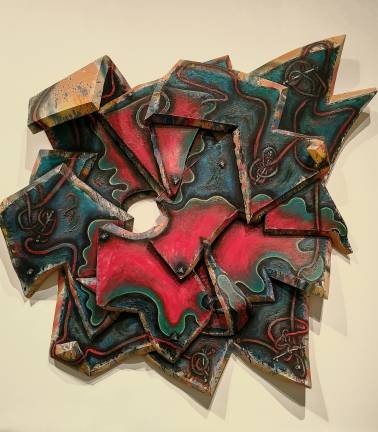Immersed in art and ideas

Artists have many ways to communicate. They can use imagery, emotion, color and line, form, shape and movement. Metaphor, allusion, language — the list is as limitless as the imagination. Curators also tell stories, but they have fewer tools. They select pieces, write texts to elucidate them, and then arrange works within a given space. It’s a lot harder than it seems, and the stories come through in different degrees and a variety of ways. Curator Randall Griffey’s presentation “Epic Abstraction” illustrates how.
The exhibition highlights more than 50 works from the Met’s permanent collection, starting from the 1940s and continuing to the present. It’s an epic tale that includes enormous changes to art, society, and life as we know it. Two world wars changed the psyche of humankind. They also changed the map of the art world. Images shifted to the surreal with dreamlike scenes offering a break from harsh realities, even as they expressed the spirit’s unsettled response. Then, beyond that, art morphed into fields without any recognizable pictorial elements. Abstraction stormed the art world, and New York became its epicenter as artists from all over Europe immigrated to the world’s welcoming new cultural capital.
Powerful and MesmerizingArtists of the time spoke of an expansiveness, a collective sigh of relief at the end of the wars. Paintings became dynamic, intellectually rooted, and super-sized. Lots of them are on view and they give a sense of the historical underpinnings of Abstract Expressionism, an American invention as authentic and unique as jazz.
“The Met’s great holdings of post-war art include some of the most celebrated examples of Abstract Expressionism.” said Max Hollein, Director of the Museum. “These monumental works also offer a powerful — even mesmerizing — experience.”
That’s one story that runs through the exhibition. But another narrative kept whispering to me as I walked through the galleries. Major massive works by Jackson Pollock (“Autumn Rhythm (Number 30)”), Clyfford Still (“1950-E” and “1950-W”), Ellsworth Kelly (“Blue Panel II”), and a whole suite of stunning paintings by Mark Rothko filled the rooms. By the third gallery, the question in my mind had fully formed.
Hey, wait a minute, where are all the women who painted in the 1950s,’60s and beyond?
At the far corner I spotted Hedda Sterne’s 1953 cool grey, black, and white linear abstraction “New York #2.” Then, turning a corner, a surprise was waiting. Chakaia Booker’s powerful sculpture, “Raw Attraction,” from 2001 exerted its presence in a room of largely monochromatic paintings. She uses industrial materials — here cut up sections of tire treads — to create her biomorphic shapes. Another turn led to a gallery filled with exuberant, commanding paintings and sculptures, almost all of them by women artists.
An Arc of Women’s Art History They were there all along. They had carved a place out for themselves. And it wasn’t their fault if it took so many so long to notice, their placement seemed to say.
Louise Nevelson’s “Mrs. N’s Palace” is a major opus that expresses all that may be familiar about Nevelson’s work in an unfamiliar way. It’s the largest work she ever made, and took thirteen years to complete. The size of a small building, it needs to be walked around, peered into, and stepped back from to take it all in. Nearby is Carmen Herrera’s minimalist exploration of positive and negative space, “Equilibrio” from 2012. Ebullient stripes of rainbow hues fill two canvases by Op artist, Bridget Riley.
Joan Snyder’s “Smashed Strokes Hope” with its virtuosity of technique (drips, stains, varyingly delicate and impasto brushwork!) gave me a new artist to admire, investigate and watch for. The exhibition text tells us that Snyder said, “I wanted a beginning, middle, and end, many different parts, happy, sad, tragic parts, many things happening at once, different instruments, different sounds, rhythms.”
The final gallery and Elizabeth Murray’s shaped canvas “Terrifying Terrain” offered a perfect ending. The jagged edges and stacked sculptural shapes were meant to evoke a mountain climbing trip the artist once took. Dizzying angles, a vertiginous ascent, yet, finally, she made it to the top.
No matter how it communicates, once the artist puts down her brush — or chisel, or scissors, or hammer, or camera — art is left to the eye of the beholder. I sensed the arc of women’s art history in the exhibition. Others may find ideas of popular culture, mass media, globalization, or any other echo these works ping in their minds. That’s the whole reason to go.